#aeolidida
Photo
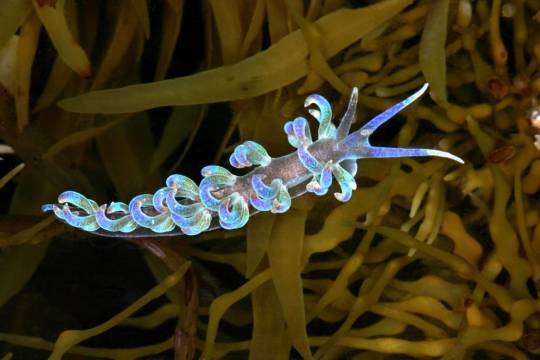
Sea slug (Phyllodesmium macphersonae).
#sea slug#sea slugs#phyllodesmium#phyllodesmium macphersonae#nudibranch#nudibranchs#gastropod mollusc#gastropod molluscs#aeolid#aeolidida#aeolid nudibranch#aeolid nudibranchs#water#underwater#ocean#marine#sea#aquatic#animal#animals#museumsvictoria#nature
10K notes
·
View notes
Text


Cerata, singular ceras, are anatomical structures found externally in nudibranch sea slugs, especially in aeolid nudibranchs, marine opisthobranch gastropod mollusks in the clade Aeolidida. The word ceras comes from the Greek word "κέρας", meaning "horn", a reference to the shape of these structures.
Cerata are dorsal and lateral outgrowths on the upper surfaces of the body of these nudibranchs.
Cerata greatly extend the surface area of nudibranchs and aid in respiration, the process of gas exchange for metabolic use.[1]
Cerata are also used, in some cases, for attack and defense. In many aeolid nudibranchs, the digestive system extends into the cerata. These nudibranchs eat stinging celled animals (Cnidarians) such as anemones, hydroids and sea fans or Portuguese men o' war. The stinging cells or nematocysts are passed unharmed through the digestive system to cnidosacs at the tips of the cerata. Here the nematocysts mature and are then used by the nudibranch for its own defense.
those are his lungs...
4 notes
·
View notes
Photo
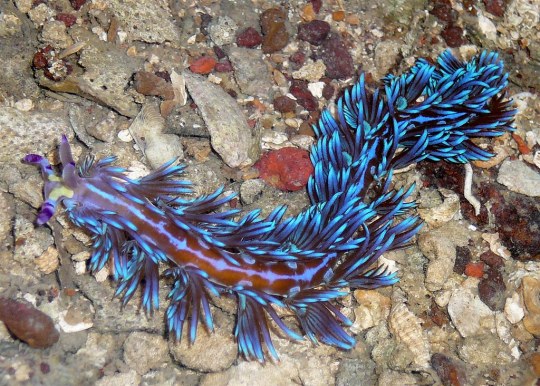
Blue dragon nudibranch (Pteraeolidia ianthina)
Photo by Loh Kok Sheng
#blue dragon#nudibranch#pteraeolidia ianthina#pteraeolidia#facelinidae#aeolidioidea#aeolidida#cladobranchia#dexiarchia#nudibranchia#nudipleura#euthyneura#heterobranchia#gastropoda#mollusca#lophotrochozoa
301 notes
·
View notes
Photo

ミノウミウシの仲間 Aeolidida spp.
68 notes
·
View notes
Photo
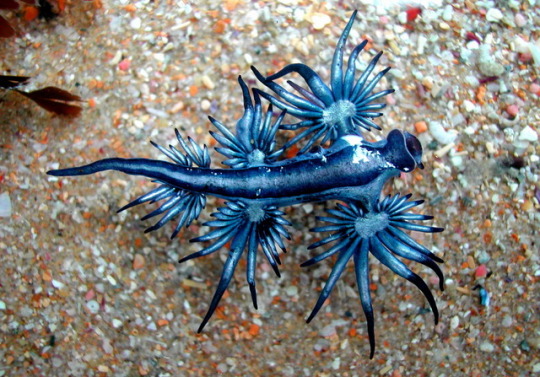
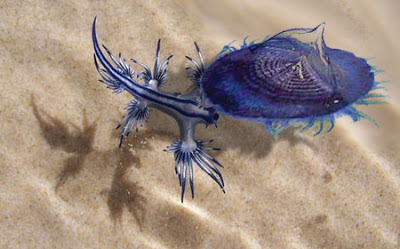

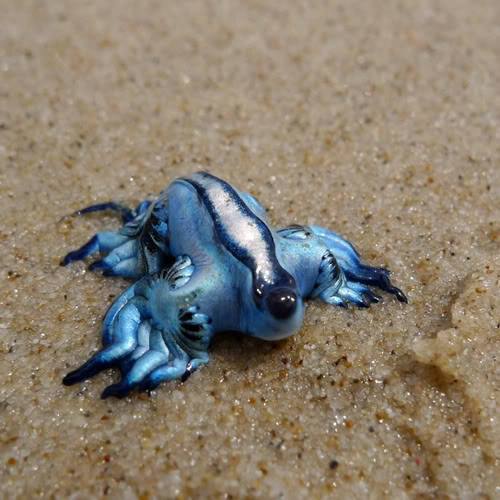
The Glaucus atlanticusis is known as the “sea swallow” or the “blue dragon” and store nematocysts from the jellyfish they feed on, giving them the ability to defend themselves from predators. Sea swallows are actually pelagic, meaning they swim upside down and allow the currents to carry their bodies.
clade Heterobranchia
clade Euthyneura
clade Nudipleura
clade Nudibranchia
clade Dexiarchia
clade Cladobranchia
clade Aeolidida
7 notes
·
View notes
Text
Glaucus Atlanticus ( The Blue Dragon from Pokemon!!!)
These sea slugs are pelagic

This organism looks just like a Pokemon character. Glaucus Atlanticus aka Blue Dragon is very beautiful but also life threating. The Blue Dragons grow up to 3 centimeters long. They float at the surface of the water and on their backs for camouflage. Their belly is blue to blend in with the blue water. And their camouflage for their back blends in with the brightness of the surface of the water. Blue Dragons’ taxonomy classification:
Kingdom: Animalia
Phylum: Mollusca
Class: Gastropoda
(unranked):
clade Heterobranchia
clade Euthyneura
clade Nudipleura
clade Nudibranchia
clade Dexiarchia
clade Cladobranchia
clade Aeolidida
Superfamily: Aeolidioidea
Family: Glaucidae
Genus: Glaucus
Species: G. Atlanticus
1 “These sea slugs are pelagic...Glaucus Atlanticus feeds on other pelagic creatures” such as poisonous creatures. The poison doesn’t affect the Blue Dragons. They the poison for their own use. “ They are known to prey on the dangerously venomous Portuguese man o' war (Physalia physalis); the by-the-wind-sailor (Velella velella); the blue button (Porpita porpita); and the violet snail, Janthina janthina.” Blue Dragons have 1 “been recorded from the east and south coasts of South Africa, European waters, the east coast of Australia, and Mozambique.” “[T]hey live in warm temperate climates in the Southern Pacific, and in circumtropical and Lusitanian environments...”
youtube
The wing-like arms/legs are called appendages. Blue Dragons have six appendages. The finger-like branches are called cerata. Their cerata are able to sting, more than likely due to the fact that they eat venomous organisms. 1“Glaucus is a hermaphrodite, having both male and female reproductive organs.” 1“After mating, both animals produce egg strings.”
youtube
1https://en.wikipedia.org/wiki/Glaucus_atlanticus
2http://eol.org/pages/451180/details
0 notes
Photo

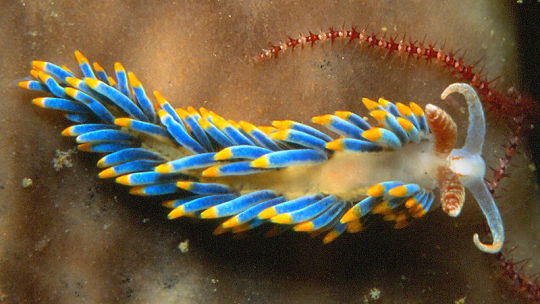
Berghia coerulescens
...a species of aeolid nudibranch that is native to European, Mediterranean, and Caribbean waters. B.coerulescens is usually found in temperate and warm waters in depths of around 1 meter. Like other nudibranchs this species typically feeds on sessile marine invertebrates and favors sea anemones.
This species is sometimes used in the aquarium trade to deal with anemone pests (members of the genus and Aiptasia).
Phylogeny
Animalia-Mollusca-Gastropoda-Aeolidida-Aeolidioidea-Aeolidiidae-Berhia-B.coerulescens
Images: Dominique Horst and Parent Gery
#Berghia coerulescens#Nudibranch#Gastropoda#Mollusca#Aeolidida#Aeolidioidea#Ocean#Atlantic#Caribbean#Heterobranchia#Euthyneura#Nudipleura#Nudibranchia#Dexiarchia#Cladobranchia#Aeolidiidae#Berghia
386 notes
·
View notes
Photo

Nudibranch (Phyllodesmium briareum)
Photo by Roar Sæthre
#id'ing#nudibranch#phyllodesmium briareum#phyllodesmium#favorininae#facelinidae#aeolidioidea#aeolidida#cladobranchia#dexiarchia#nudibranchia#nudipleura#euthyneura#heterobranchia#gastropoda#mollusca#lophotrochozoa
23 notes
·
View notes
Photo

ミノウミウシの仲間 Aeolidida spp.
26 notes
·
View notes
Photo

ミノウミウシ小目の一種 Aeolidida ssp.
31 notes
·
View notes
Photo

ミノウミウシ小目の1種 Aeolidida sp.
42 notes
·
View notes
